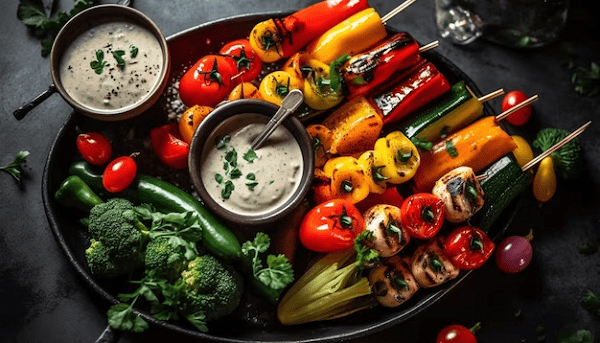Garnishes & accompaniments- Garnishes and accompaniments are elements used to enhance the presentation and flavor of a dish. They can add texture, color, and contrast to a meal, making it more visually appealing and providing complementary tastes and textures. Here are some common garnishes and accompaniments:
Garnishes:
- Herbs: Fresh herbs like parsley, cilantro, basil, and chives can add a burst of freshness and color to a dish.
- Citrus Zest: Grated or thinly sliced zest from citrus fruits (lemon, lime, orange) can provide a zesty, aromatic flavor.
- Microgreens: Tiny, edible greens like micro basil or arugula are delicate and can be used to decorate dishes.
- Edible Flowers: Certain flowers like nasturtiums, pansies, and violets are edible and make for a stunning garnish.
- Seeds and Nuts: Toasted sesame seeds, crushed nuts, or pumpkin seeds can add a crunchy element to a dish.
- Spices and Seasonings: A sprinkle of paprika, cayenne, or ground black pepper can provide a burst of flavor and color.
- Sauces and Drizzles: A well-placed drizzle of balsamic reduction, aioli, or olive oil can enhance the dish’s visual appeal and flavor.
Accompaniments:
- Rice: Steamed rice, whether plain or flavored (e.g., saffron or coconut rice), is a common accompaniment to many dishes.
- Bread: Different types of bread, like baguette, naan, or pita, can be served with a variety of dishes.
- Vegetables: Roasted, grilled, or steamed vegetables are often served alongside main courses.
- Salads: Fresh green salads, coleslaw, or pasta salads can complement a variety of dishes.
- Potatoes: Mashed, roasted, or fried potatoes are classic accompaniments to many meat dishes.
- Sauces and Condiments: Ketchup, mustard, mayo, and various dipping sauces can enhance the flavor of many dishes.
- Pickles and Chutneys: Pickled vegetables or fruit chutneys can add a tangy or sweet contrast to savory dishes.
- Gravy: Gravy is a common accompaniment for meats, especially in dishes like roast dinners.
- Salsas: Fresh salsas made from tomatoes, onions, and other ingredients can add a burst of flavor to many dishes.
- Cheese: Cheese platters with a selection of cheeses, fruits, and nuts can be a delightful accompaniment to wine or appetizers.
The choice of garnishes and accompaniments can vary widely depending on the type of cuisine, cultural traditions, and personal preferences. They are often used to elevate the overall dining experience and create a harmonious balance of flavors, textures, and aesthetics in a meal.
What is Garnishes & accompaniments
Garnishes and accompaniments are culinary elements used to enhance the presentation, flavor, and overall dining experience of a dish. They are typically served alongside or on top of the main course or dish and serve various purposes:
- Garnishes: Garnishes are decorative elements added to a dish to improve its visual appeal. They can include herbs, spices, or colorful ingredients that add a pop of color and texture. While garnishes are often edible, their primary role is to make the dish more aesthetically pleasing. Common examples of garnishes include fresh herbs, citrus zest, edible flowers, or decorative sauces.
- Accompaniments: Accompaniments are side dishes or components that complement the main dish. They are chosen to balance the flavors, textures, and overall meal experience. Accompaniments can be selected to enhance the main dish’s taste and provide a well-rounded meal. Common accompaniments include rice, vegetables, bread, sauces, and condiments.
The choice of garnishes and accompaniments can vary greatly depending on the type of cuisine, cultural traditions, and the specific dish being served. They play a crucial role in elevating the overall dining experience by providing a combination of visual appeal and flavor harmony.
Who is Required Garnishes & accompaniments
The use of required garnishes and accompaniments can vary widely depending on the type of dish, cultural traditions, and individual preferences. In most cases, there are no strict rules that mandate specific garnishes or accompaniments for particular dishes. However, there are some general guidelines and common practices in different cuisines:
- Cultural Traditions: Certain cuisines have traditional accompaniments and garnishes that are commonly associated with specific dishes. For example, in Japanese cuisine, sashimi is often served with pickled ginger and wasabi as standard accompaniments. In Mexican cuisine, tacos may come with garnishes like salsa, guacamole, and cilantro.
- Personal Preferences: The choice of garnishes and accompaniments can be highly influenced by personal taste. Some people may prefer a particular sauce, herb, or side dish with their meals, and chefs often accommodate these preferences in restaurants.
- Balancing Flavors and Textures: Chefs often choose garnishes and accompaniments to balance the flavors and textures of a dish. For example, a rich, heavy main course might be served with a light and refreshing salad to create a harmonious dining experience.
- Aesthetic Presentation: Garnishes are used to make a dish more visually appealing. Chefs use colorful herbs, edible flowers, or decorative elements to enhance the dish’s presentation and create an attractive plate.
- Regional Variations: The same dish may be served with different garnishes and accompaniments in different regions or countries. For instance, a steak in Argentina may be served with chimichurri sauce, while in the United States, it might be accompanied by a baked potato.
In summary, there is no universally required set of garnishes and accompaniments for all dishes. The choice is flexible and often based on cultural traditions, personal preferences, and the desire to create a balanced and visually appealing meal. Chefs and home cooks have the creative freedom to experiment with different combinations to enhance the dining experience.
When is Required Garnishes & accompaniments

Required garnishes and accompaniments are typically specified in recipes or culinary traditions for particular dishes or cuisines. In such cases, they are considered essential elements to complete the dish or to ensure a specific flavor profile or presentation. Here are some situations where required garnishes and accompaniments are commonly used:
- Traditional or Classic Dishes: Many traditional and classic dishes come with specific garnishes and accompaniments that are considered integral to the dish. For example, a classic Caesar salad is expected to have croutons, Parmesan cheese, and Caesar dressing as essential components.
- Cultural or Regional Requirements: Certain cuisines have well-established rules for garnishes and accompaniments. These can be based on cultural traditions and are expected to be included to maintain the authenticity of the dish. For instance, a traditional Korean bibimbap will include a fried egg, gochujang sauce, and kimchi as accompaniments.
- Cocktails and Beverages: Garnishes for cocktails are often specified and are considered essential for both flavor and presentation. A classic martini is expected to come with a green olive or a lemon twist as a garnish.
- Special Diets or Dietary Restrictions: In cases where individuals have dietary restrictions or allergies, specific garnishes or accompaniments may be required to accommodate those needs. For example, a gluten-free dish might require gluten-free bread as an accompaniment.
- Plating and Presentation: Fine dining and culinary competitions often have strict requirements for plating, which may include specific garnishes and accompaniments to create an elegant and cohesive presentation.
- Chef’s Recommendations: In some upscale restaurants, the chef’s recommendations are considered the standard way to serve a dish. These recommendations often include garnishes and accompaniments that are essential to the chef’s vision of the dish.
In these cases, it’s important to follow the recipe or tradition closely and include the required garnishes and accompaniments as specified. However, for most home cooking and casual dining situations, there is more flexibility in choosing garnishes and accompaniments based on personal preferences and what ingredients are available.
Where is Required Garnishes & accompaniments
Required garnishes and accompaniments are typically specified in recipes, culinary traditions, or cultural norms associated with a specific dish or cuisine. These requirements can vary depending on the type of dish, regional influences, and personal preferences. Here’s where you can commonly find information about required garnishes and accompaniments:
- Recipes: Most recipes provide a list of ingredients, including garnishes and accompaniments, that are essential for preparing a particular dish. These recipes outline the required elements to ensure that the dish turns out as intended.
- Culinary Tradition and Cultural Norms: Traditional dishes from various cuisines often come with established norms for garnishes and accompaniments. These norms are deeply rooted in the culinary heritage of a region or culture. For example, a traditional Italian pasta dish like spaghetti carbonara is typically served with grated Pecorino Romano cheese and pancetta as garnishes.
- Cookbooks: Cookbooks authored by experienced chefs or experts in a specific cuisine often provide guidance on how to prepare a dish authentically, including the required garnishes and accompaniments.
- Online Resources: Many cooking websites and apps feature recipes that specify the necessary garnishes and accompaniments for a wide range of dishes. Websites and forums dedicated to specific cuisines or cooking styles can also provide valuable insights.
- Chefs and Culinary Experts: In fine dining establishments or on cooking shows, chefs and culinary experts may recommend specific garnishes and accompaniments to enhance a dish’s flavor and presentation. These recommendations are often considered the standard for that particular preparation.
- Food and Beverage Menus: In restaurants and bars, menus usually provide descriptions of the dishes and drinks, including details about their garnishes and accompaniments. This is especially relevant for cocktails and mixed drinks.
It’s important to note that while required garnishes and accompaniments are often specified, there is room for creativity and personalization in cooking. Depending on your own preferences and dietary restrictions, you can adjust or experiment with the recommended elements to suit your taste. However, if you’re aiming to create an authentic or traditional version of a dish, it’s advisable to follow the specified requirements closely.
How is Required Garnishes & accompaniments
The requirements for garnishes and accompaniments in a dish can vary depending on the specific recipe, culinary traditions, and cultural norms. Here is a general overview of how required garnishes and accompaniments are typically included:
- Follow the Recipe: When preparing a dish, the first step is to carefully read and follow the recipe. Recipes typically list all the ingredients required, including garnishes and accompaniments. Make sure to note the specific garnishes and accompaniments mentioned in the recipe’s instructions.
- Prepare the Garnishes: Prepare the garnishes as specified in the recipe. This may involve chopping herbs, grating cheese, zesting citrus fruits, or any other specific garnish preparation. Pay attention to the recipe’s guidance on the size and quantity of the garnishes.
- Cook the Dish: Proceed with cooking the main dish according to the recipe’s instructions. Garnishes and accompaniments are typically added toward the end of the cooking process or just before serving. For example, fresh herbs may be sprinkled on top of a completed dish, or a sauce may be drizzled over it.
- Plate the Dish: When plating the dish, arrange the garnishes and accompaniments as specified. This is where you can get creative with presentation. Consider how the garnishes will enhance the visual appeal of the dish.
- Serve and Enjoy: Once the dish is plated with the required garnishes and accompaniments, it’s ready to be served and enjoyed. The garnishes and accompaniments are not only for visual appeal but also contribute to the overall flavor and dining experience.
- Personalization: While it’s important to follow the recipe for authentic or traditional preparations, you can also personalize garnishes and accompaniments based on your taste preferences. For instance, if the recipe calls for a specific herb, but you prefer another, you can make that substitution.
- Dietary Considerations: If you have dietary restrictions or allergies, you may need to make substitutions for certain garnishes or accompaniments. Always consider your dietary needs while following a recipe.
Remember that the specific requirements for garnishes and accompaniments will vary from dish to dish and recipe to recipe. It’s essential to pay close attention to the instructions provided in the recipe you are following. Following the recipe closely will help you achieve the desired flavors and presentation for the dish.
Case Study on Garnishes & accompaniments
Enhancing the Dining Experience at “Savor Delights” Restaurant
Background: “Savor Delights” is a fine dining restaurant known for its creative and innovative cuisine. The head chef, Chef Olivia, is committed to providing a memorable dining experience for guests through the use of unique and visually appealing garnishes and accompaniments.
Challenge: The restaurant’s management noticed that while the main dishes at “Savor Delights” were exceptional, they wanted to further elevate the dining experience by incorporating more thoughtfully chosen and creative garnishes and accompaniments. The goal was to stand out in a competitive market and create a unique identity for the restaurant.
Approach: Chef Olivia and her team decided to revamp their menu and approach to garnishes and accompaniments. They took the following steps:
- Menu Redesign: The menu was redesigned to highlight not only the main dishes but also the garnishes and accompaniments that would accompany each dish. This allowed the guests to have a clear idea of the full culinary experience.
- Culinary Creativity: The kitchen staff was encouraged to explore innovative garnishes and accompaniments that would complement the flavors and aesthetics of each dish. This included experimenting with unusual ingredients and flavor combinations.
- Local and Seasonal Ingredients: “Savor Delights” committed to sourcing local and seasonal ingredients for their garnishes and accompaniments. This not only added freshness but also supported local farmers and suppliers.
- Presentation: The plating techniques were refined to ensure that each dish was not only delicious but also visually stunning. The restaurant invested in unique serving plates and utensils to enhance the overall presentation.
Results: The new approach to garnishes and accompaniments at “Savor Delights” had a significant impact:
- Positive Customer Feedback: Guests were delighted by the creative and aesthetically pleasing garnishes and accompaniments. Many took to social media to share their dining experiences, resulting in increased visibility and customer engagement.
- Repeat Business: The enhanced dining experience encouraged repeat visits from satisfied customers, leading to increased revenue and loyalty.
- Media Attention: The restaurant garnered media attention for its culinary innovation, leading to positive reviews in local food publications and blogs.
- Unique Identity: “Savor Delights” established itself as a unique culinary destination in the area, attracting both local and out-of-town diners.
- Collaboration: Chef Olivia and her team began collaborating with local artisans and craftsmen to create custom servingware, further setting the restaurant apart from competitors.
Conclusion: Incorporating creative and thoughtfully chosen garnishes and accompaniments not only enhanced the dining experience at “Savor Delights” but also contributed to its success and unique identity in the competitive restaurant industry. The case study demonstrates how attention to detail, culinary creativity, and a focus on presentation can make a significant impact on a restaurant’s reputation and business growth.
White paper on Garnishes & accompaniments
Title: Enhancing Culinary Experiences with Garnishes and Accompaniments
Abstract:
This white paper explores the role of garnishes and accompaniments in the culinary world. Garnishes and accompaniments play a vital role in enhancing the overall dining experience, both in terms of aesthetics and flavor. They provide chefs and home cooks with creative opportunities to elevate their dishes, offering a multitude of textures, colors, and tastes. This white paper delves into the significance of these culinary elements, their cultural and regional variations, and their impact on the art of plating and presentation.
Table of Contents:
Introduction
1.1. Definition of Garnishes and Accompaniments
1.2. The Importance of Garnishes and Accompaniments
Historical and Cultural Perspectives
2.1. Historical Evolution
2.2. Cultural Significance
2.3. Regional Variations
Types of Garnishes
3.1. Fresh Herbs
3.2. Edible Flowers
3.3. Citrus Zest
3.4. Spices and Seasonings
3.5. Seeds and Nuts
3.6. Microgreens
3.7. Sauces and Drizzles
Common Accompaniments
4.1. Rice and Grains
4.2. Bread and Baked Goods
4.3. Vegetables
4.4. Salads
4.5. Potatoes
4.6. Sauces and Condiments
4.7. Cheese and Dairy Products
The Art of Plating and Presentation
5.1. Plating Techniques
5.2. Visual Appeal
5.3. Balance of Flavors
5.4. Textures and Layers
Culinary Creativity
6.1. Innovation in Garnishes and Accompaniments
6.2. Seasonal and Local Ingredients
6.3. Chef’s Signature Touch
Dietary Considerations
7.1. Accommodating Dietary Restrictions
7.2. Vegetarian, Vegan, and Gluten-Free Options
Case Studies
8.1. Case Study 1: Elevating Fine Dining with Creative Garnishes
8.2. Case Study 2: Traditional Garnishes in Ethnic Cuisine
8.3. Case Study 3: Garnishes and Accompaniments in Health-Conscious Menus
Conclusion
9.1. The Future of Garnishes and Accompaniments
9.2. The Role of Garnishes and Accompaniments in Culinary Arts
References
This white paper will provide an in-depth exploration of the world of garnishes and accompaniments, their historical and cultural significance, types and varieties, and their impact on the art of plating and presentation. It will also examine the evolving trends and creativity in garnishes and accompaniments, as well as considerations for accommodating dietary preferences and restrictions. Through case studies, it will demonstrate how these elements have been utilized to enhance the dining experience in various culinary settings.
Industrial Application of Garnishes & accompaniments
Garnishes and accompaniments, which are typically associated with the culinary world, may not have direct industrial applications in the traditional sense. However, there are related industrial applications and contexts where the concepts of enhancing presentation, flavor, and overall customer experience align with the principles of garnishes and accompaniments. Here are some industrial applications and examples where these concepts play a role:
- Food Packaging and Presentation:
- In the food manufacturing industry, the presentation of packaged foods is critical for marketing and sales. While not garnishes in the traditional sense, food companies often use artistic packaging, labels, and designs to make their products visually appealing.
- Frozen Foods and Convenience Meals:
- Manufacturers of frozen foods and convenience meals often include sauces, seasoning packets, or garnish-like components within the packaging. These elements allow consumers to customize the dish’s flavor and appearance to their liking.
- Ready-to-Eat Meals for Airlines and Catering:
- Companies that provide ready-to-eat meals for airlines and catering services pay attention to presentation. Components like pre-packaged sauces, herbs, or decorative elements are included to enhance the dining experience.
- Food Service Equipment and Plating Tools:
- Industrial applications can involve the design and production of food service equipment and plating tools. These tools, such as garnishing kits, precision tweezers, and specialized plating utensils, are used by chefs and food service professionals to create visually appealing presentations.
- Restaurant Chain Production:
- In large restaurant chains and franchises, industrial-scale food production often involves pre-portioned ingredients, including sauces, condiments, and garnishes, to ensure consistency in taste and presentation across multiple locations.
- Food Processing and Ingredients:
- Companies that manufacture food ingredients may produce items like dehydrated herbs, freeze-dried fruits, or powdered seasonings that are used as garnishes or accompaniments by foodservice providers.
- Food Photography and Styling:
- While not directly related to food production, the food photography and styling industry focuses on making dishes look enticing for marketing purposes. This includes using garnishes, props, and plating techniques to create visually appealing food images.
- Culinary Competitions:
- In culinary competitions and food innovation challenges, chefs and food professionals often experiment with new ingredients, garnishes, and accompaniments to push the boundaries of culinary artistry and taste.
In these industrial contexts, the principles of enhancing presentation, flavor, and customer experience are vital. While the specific components may not always be referred to as garnishes and accompaniments, the ideas behind them remain relevant, even in large-scale food production and service. Industrial applications aim to deliver appealing and high-quality food experiences to consumers and clients, just as garnishes and accompaniments do in the culinary world.





